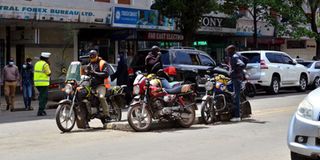Premium
Why walking on Nairobi streets is a highly risky affair
Boda-boda riders on the newly created walkways along Muindi Mbingu Street on October 16, 2020.
Who has the right of way? That is the question many pedestrians in Nairobi keep asking themselves even with the recent conversion of several parking lots in the city centre into walkways and cycling paths.
Every day, many pedestrians in Nairobi risk their lives on the roads as a result of inconsiderate boda-boda riders and uncouth motorists.
It’s a risky gamble with their lives following the invasion of pedestrian safety facilities by boda-bodas and other motorists.
From parking on sidewalks to riding on them, boda-boda riders are every pedestrian’s worst nightmare in Nairobi.
A boda-doda rider rests on his motorbike along Moi Avenue next to a zebra crossing sign on October 16, 2020.
About half of city residents walk or cycle, either by choice or for scarcity of resources. The reality, however, is that most pedestrians will continue chancing their lives on the busy roads as they have no other choice.
A matter of life and death
Walking on pavements has become a matter of life and death for many city dwellers, thanks to rogue boda-boda riders who are known to break every traffic rule in the book.
These serial traffic offenders ride dangerously and hoot to force their way through crowded walkways. But when they are in a real hurry, they will simply breeze past pedestrians at break-neck speed.
Data on casualties of motorbike accidents paints a grim picture.
“I’ve attended to many pedestrians injured by boda-boda riders. Some have suffered broken limbs, bone fractures, joint and soft tissue injuries, as well as lacerations and deep abrasions,” Grace Mulinge, a nurse at a city hospital, told the Nation.

Boda-boda riders in the middle of Wabera Street on October 16, 2020.
But it is not just boda-bodas which are competing with pedestrians for the walkways. Hawkers and street families, too, have made life extremely difficult for pedestrians.
Some hawkers have gone as far as setting up shop on footbridges. Walking in the streets of Nairobi is not just about evading speeding boda-bodas. You still have to hop and skip over an assortment of wares laid on the walkways by hawkers.
Needless to say, the invasion of these crucial pedestrian safety facilities has made nonsense of the multi-million-shilling road investments recently put up by the Nairobi Metropolitan Services (NMS) and those in the pipeline.
That said, the ability to manoeuvre through traffic, especially during peak hours, is the unique selling point for boda-bodas, which are popular with many Nairobians for their promptness.
To beat traffic, many motorcyclists use sidewalks to weave through congested roads that often resemble packed parking lots.
Mwihaki Mwaura, a boda-boda rider who operates at the Globe Cinema Roundabout, wondered why I was even asking why they don’t seem to care about pedestrians who are also their customers.
“How do you expect me to answer that? We also have to earn a living. If you want to use our services you are welcome, if you don’t, I will not bother you,” he said.
For good measure, Mwaura unapologetically said he has no qualms with forcing pedestrians out of his way to get his customers to their destinations in the shortest possible time.
“I will use the shortest way I can. Do you ever see traffic police officers stopping us?” he asked rhetorically.
Another boda-boda rider in Eastlands’ Mutindwa area said he often uses the footbridge whenever the need arises.
“The footbridge is a short-cut to the other side of the road. It helps me beat traffic jams,” said the rider, who sought anonymity.
Apparently, pedestrians in Nairobi are just as likely to get knocked down on footbridges as they are while crossing the road below.
The boda-boda menace in Nairobi is largely abetted by corrupt county askaris and complacency on the part of Nairobians, who find it easier to ride along as opposed to holding these traffic offenders to account.
Level of impunity is exhibited by some motorists
The same level of impunity is exhibited by some motorists in the city centre.
Along Monrovia Street, it is common to see pedestrians walking right in the middle of the road, as the walkways have been turned into ''parking bays''.
A vehicle parked on a pavement along Banda Street, which is against the county by-laws.
A county parking attendant who spoke to the Nation said there is nothing they could do about it.
“We let them park there because their vehicles stay there for long. These motorists also don’t want to pay Sh200 for less than an hour,” she said.
On Rabai Road, the walkway, which was recently constructed, is similarly inaccessible to pedestrians.
George Nyagah, the director of Road Safety Volunteers, says the boda-boda menace and parking of vehicles on pavements in the city centre can only be addressed through strict enforcement from all the relevant authorities.
“You realise road accident statistics have reached alarming levels, considering pedestrians constitute the highest number of fatalities and injuries,” he said.
According to Mr Nyagah, errant motorists and riders are largely to blame since some of them don’t respect non-motorised transport traffic sections.
“The solution would be for boda-boda riders to get organised, lobby for designated parking, follow traffic rules and self-regulate as matatus do. While we appreciate the key role they play in the transport industry, a majority of them seem to enjoy working in a chaotic and disorganised system,” he said.
Data from the National Transport and Safety Authority (NTSA) shows that pedestrians and cyclists have had to dangerously share the road space with speeding motorists and riders, resulting in as many as 3,000 deaths yearly.
To address this issue, since taking over key functions of the county government – including transport and public works – NMS has enhanced non-motorised transport and walking spaces within the CBD.
Replacement of on-street parking spots with pedestrian walkways and cycling lanes was expected to make it easy for residents to walk or cycle in the city centre. However, there are problems when it comes to enforcement of a right of way on these new facilities.
And now there is an even bigger struggle for parking space within the CBD. This perhaps explains why rogue motorists have resorted to shamelessly parking along the beautiful walkways, inconveniencing pedestrians and cyclists in the process.
Vehicles parked along the newly created pavement along Kenyatta Avenue. With fewer parking spaces in the city, most drivers are opting to park illegally.
To solve this problem, NMS has promised to accommodate the affected motorists, who relied on street parking, in silo and sunken car parks, which it plans to develop.
And to further decongest the city centre, NMS announced that matatus will be kicked out of the city centre by the end of November.
This will see all public service vehicles terminate their journey outside the CBD at respective bus parks which include Muthurwa, Ngara and Pangani, among other identified holding areas.
Road obstruction is punishable by law with Section 90 (2)(a) and 94 of NTSA regulations imposing penalties of Sh10,000 for such traffic offenders while a motorist who drives through pavements or pedestrian walkways is liable to a fine of Sh5,000.
Under 90 (2)(c) and 94 of the same regulations, pedestrians found walking in undesignated areas, such as crossing the road without using an available footprint, are liable to a fine of Sh500 for obstruction of the free passage of vehicles.
Whether these regulations are enough deterrent measures is another question altogether. What is indisputable is that the indiscipline of boda-boda riders and motorists in Nairobi, coupled with inadequate enforcement of the law, has clawed back the gains made by the new walkways and cycling paths.





